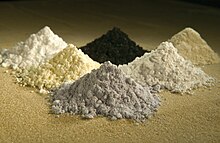Earth (historical chemistry)
Appearance

Earths were defined by the Ancient Greeks as "materials that could not be changed further by the sources of heat then available".[1] Several oxides were thought to be earths, such as aluminum oxide and magnesium oxide.[1] It was not discovered until 1808 that these weren't elements but metallic oxides.[1][2]
See also
[edit]References
[edit]Wikiquote has quotations related to Earth (historical chemistry).
- ^ a b c Generalic, Eni. "History of the rare earth elements". www.periodni.com. Archived from the original on 12 August 2014. Retrieved 12 April 2020.
- ^ "Alkaline-earth metal". Encyclopædia Britannica. Retrieved 18 April 2019.
By the early 1800s it became clear that the earths, formerly considered to be elements, were oxides, compounds of a metal and oxygen.
